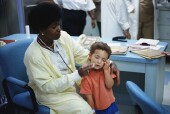
THURSDAY, Dec. 29 (HealthDay News) —
Overcrowding in emergency rooms appears to keep children with broken arms and legs from getting pain relief in a timely manner, according to a new study.
Researchers from the University of Colorado School of Medicine said their findings are significant since these injuries, known as long bone fractures, are common among children and very painful.
“Pain associated with long bone fractures can be pretty severe,” study author Dr. Marion Sills said in a university news release. “But crowded emergency departments are impacting the delivery of care on many levels, including the delivery of pain medication.”
In conducting the study, published in the December issue of the journal Academic Emergency Medicine, researchers examined 1,229 children treated in an ER over the course of one year. They found the children were 4 percent to 47 percent less likely to receive treatment in a timely fashion when the ER was very crowded (at the 90th percentile) than when it was less crowded (at the 10th percentile). The researchers also found the children were 3 percent to 17 percent less likely to receive effective care in these crowded conditions.
“The relationship between emergency department crowding and pain treatment is not unexpected,” noted Sills. “When the emergency department gets busier, staff may be less responsive to the needs of individual patients and, as a result, patients have a higher likelihood of non-treatment and delays in treatment.”
The authors said delays happen in some cases when only doctors are permitted to provide certain pain medications to patients.
“The expensive way to mitigate crowding is to hire more staff. Another way is to leverage the staff you have,” Sills said. “Institutions can use techniques like protocols for pain management with standing orders for nurses, and computer- or phone-based alerts to call attention to under-treated pain.”
Crowding is a serious issue, said Sills. “It is caused by a variety of things, from patients who too readily use emergency departments to federal policies that exacerbate the problem,” she noted. “We as a nation need to get serious about this. Crowding needs to be a policy priority at every level.”
More information
The U.S. National Institutes of Health provides more information on pain relievers.

